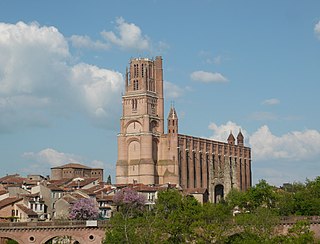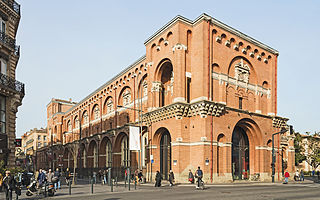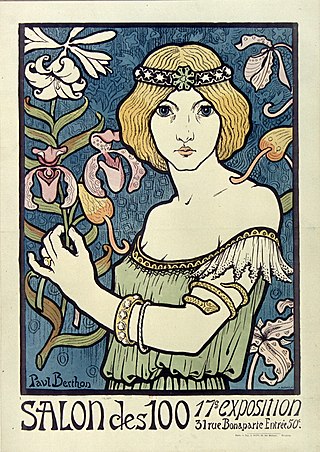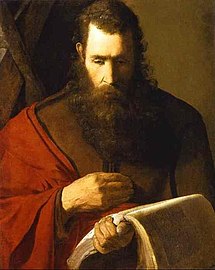
Toulouse is the prefecture of the French department of Haute-Garonne and of the larger region of Occitania. The city is on the banks of the River Garonne, 150 kilometres from the Mediterranean Sea, 230 km (143 mi) from the Atlantic Ocean and 680 km (420 mi) from Paris. It is the fourth-largest city in France after Paris, Marseille and Lyon, with 504,078 inhabitants within its municipal boundaries (2021); its metropolitan area has a population of 1.5 million inhabitants (2021). Toulouse is the central city of one of the 22 metropolitan councils of France. Between the 2014 and 2020 censuses, its metropolitan area was the third fastest growing among metropolitan areas larger than 500,000 inhabitants in France.

Comte Henri Marie Raymond de Toulouse-Lautrec-Monfa, known as Toulouse-Lautrec, was a French painter, printmaker, draughtsman, caricaturist, and illustrator whose immersion in the colourful and theatrical life of Paris in the late 19th century allowed him to produce a collection of enticing, elegant, and provocative images of the sometimes decadent affairs of those times.

Albi is a commune in southern France. It is the prefecture of the Tarn department, on the river Tarn, 85 km northeast of Toulouse. Its inhabitants are called Albigensians. It is the seat of the Archbishop of Albi.

Achille-Émile Othon Friesz, who later called himself Othon Friesz, a native of Le Havre, was a French artist of the Fauvist movement.

French art consists of the visual and plastic arts originating from the geographical area of France. Modern France was the main centre for the European art of the Upper Paleolithic, then left many megalithic monuments, and in the Iron Age many of the most impressive finds of early Celtic art. The Gallo-Roman period left a distinctive provincial style of sculpture, and the region around the modern Franco-German border led the empire in the mass production of finely decorated Ancient Roman pottery, which was exported to Italy and elsewhere on a large scale. With Merovingian art the story of French styles as a distinct and influential element in the wider development of the art of Christian Europe begins.

Louis Émile Anquetin was a French painter.

Maxime-Pierre Jules Dethomas was a French painter, draughtsman, printmaker, illustrator, and was among the best known theater-set and costume designers of his era. As an artist, Dethomas was highly regarded by his contemporaries and exhibited widely, both within France and abroad. He was a regular contributor to the Impressionistes et Symbolistes, and a founding committee member of the Salon d'Automne. In 1912, he was awarded the Chevalier de la Légion d'honneur for his contributions to French art.

The Cathedral of Saint Ceciliaof Albi, also known as Albi Cathedral, is the seat of the Catholic Archbishop of Albi. First built in the aftermath of the Albigensian Crusade, the grim exterior resembles a fortress, but the interior is lavishly decorated with art and sculpture, a very ornate choir screen, and walls in bright blues and golds, in the Toulousian or Southern French Gothic style. It was begun in 1282 and was under construction for 200 years. It is claimed to be the largest brick building in the world. In 2010 the cathedral, along with its episcopal buildings, was designated a UNESCO World Heritage Site because of its unique architecture and the remarkable consistency in its design.

The Musée des Augustins de Toulouse is a fine arts museum in Toulouse, France which conserves a collection of sculpture and paintings from the Middle Ages to the early 20th century. The paintings are from throughout France, the sculptures representing Occitan culture of the region with a particularly rich assemblage of Romanesque sculpture.

Pierre-Georges Jeanniot (1848–1934) was a Swiss-French Impressionist painter, designer, watercolorist, and engraver who was born in Geneva, Switzerland, and died in France. His work often depicts the modern life in Paris.

Blanche Hoschedé Monet was a French painter who was both the stepdaughter and the daughter-in-law of Claude Monet.
The Musée Toulouse-Lautrec is an art museum in Albi, southern France, dedicated mainly to the work of the painter Henri de Toulouse-Lautrec who was born in Albi. The 13th-century building was originally the Bishop's Palace of Albi Cathedral, next to it. It is part of the UNESCO World Heritage Site that includes the cathedral.

Salon des Cent was a commercial art exhibition in Paris, based at 31 Rue Bonaparte. The Salon sold color posters, prints and reproductions of artwork to the general public at reasonable prices. It was established in February 1894 by Léon Deschamps, founder of La Plume an avant garde literary and artistic magazine. It became known for its exhibitions showcasing the works of contemporary graphical artists. The salon held exhibitions until 1900. Many of the posters advertising Salon des Cent exhibitions have themselves become collectors' items.

Désiré Dihau was a French bassoonist and composer. He was the bassoonist painted by Edgar Degas in The Orchestra at the Opera with the cellist Louis-Marie Pilet seated behind him.

La Toilette, also known as Rousse, is a painting by Henri de Toulouse-Lautrec, from 1889. The painting depicts a red-headed woman, stripped to the waist, seated on the floor, facing away from the viewer, just before or just after bathing. Held by public collections in France since 1914, it has been at the Musée d'Orsay, in Paris, since 1983.

Le Lit is a painting by Henri de Toulouse-Lautrec from around 1892 which depicts two women sharing a bed. The painting has been held by public collections in France since 1937, and by the Musée d'Orsay in Paris since 1986.

Marie Dihau was a French singer, pianist as well as singing and piano teacher.

Le Grand Cirque is an oil and gouache on canvas painting by Belarusian-French artist Marc Chagall created in 1956. it is held in a private collection.

The Hangover (Suzanne Valadon) (French: Gueule de Bois / La Buveuse), also known as The Drinker, is an oil on canvas painting by French post-Impressionist artist Henri de Toulouse-Lautrec, created from 1887 to 1889, just before he became successful as an artist. The painting depicts a drunken woman drinking alone in a club, reflecting the counterculture of Montmartre and the specter of alcoholism among French women during the Belle Époque. The model in The Hangover is artist Suzanne Valadon, Lautrec's lover. In the early 1880s, after falling from a circus trapeze at the age of 15 and suffering a back injury, Valadon was forced to switch careers and began working as an art model in Montmartre. Although she had been drawing all her life, by 1883, she had become an artist herself, and she would go on to become the first woman painter admitted to the Société Nationale des Beaux-Arts.

Portrait of Toulouse Lautrec, in Villeneuve-sur-Yonne, with the Natansons, sometimes referred to as Toulouse-Lautrec Cooking, is an 1898 painting by French artist Édouard Vuillard. The work depicts fellow artist Henri de Toulouse-Lautrec on holiday cooking in the kitchen at Les Relais, the country home of Vuillard's patron Thadée Natanson in Villeneuve-sur-Yonne. The painting is held by the Musée Toulouse-Lautrec, in Albi.
























